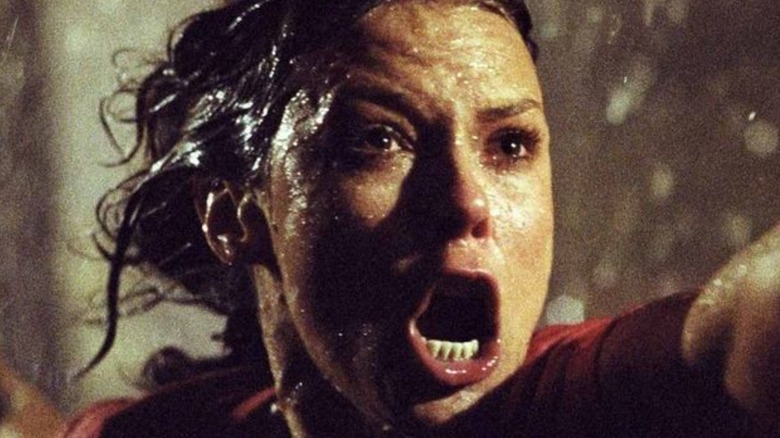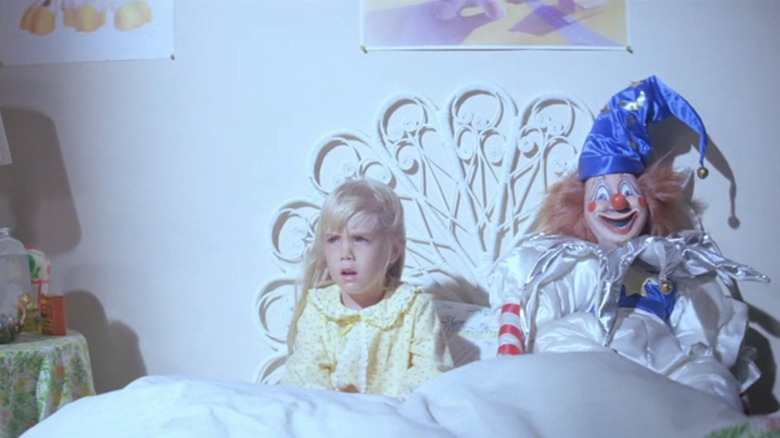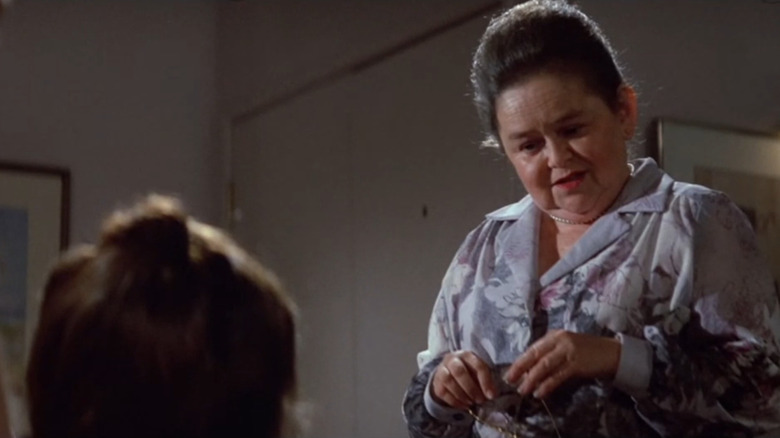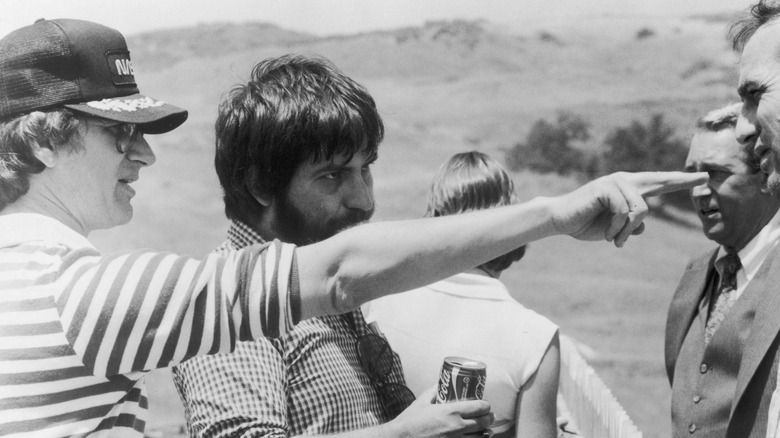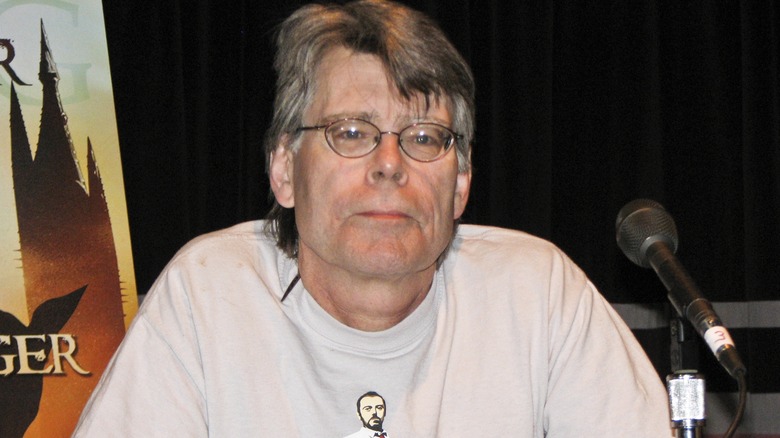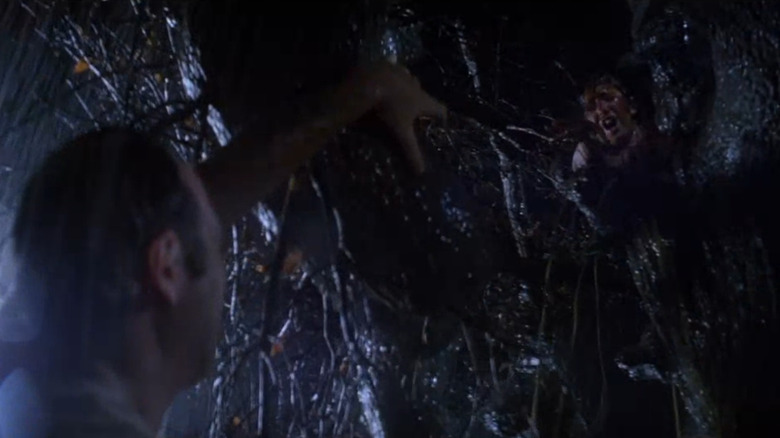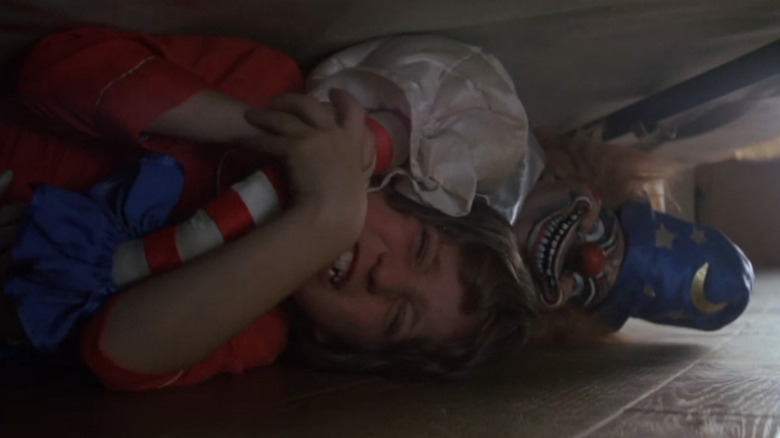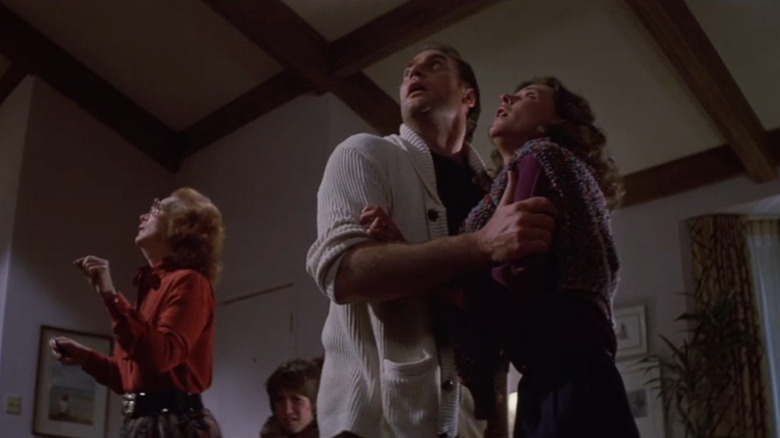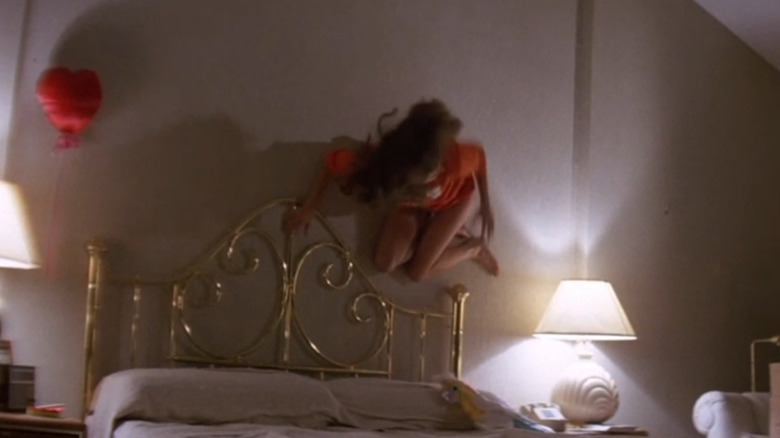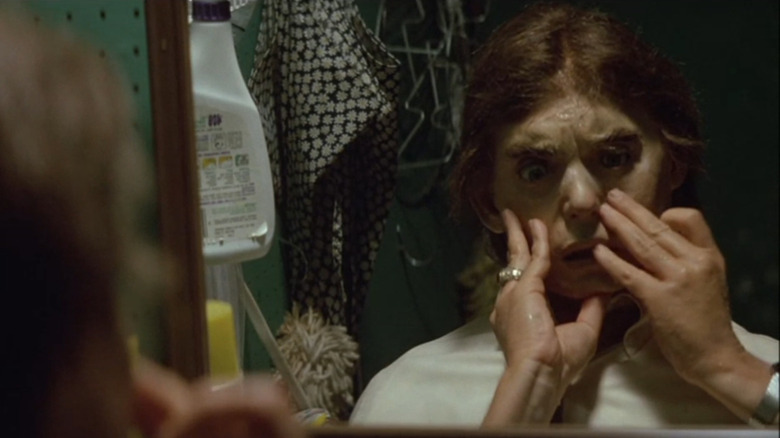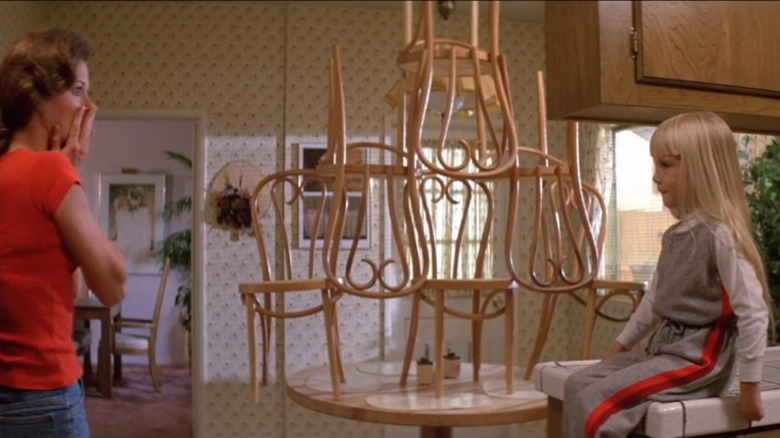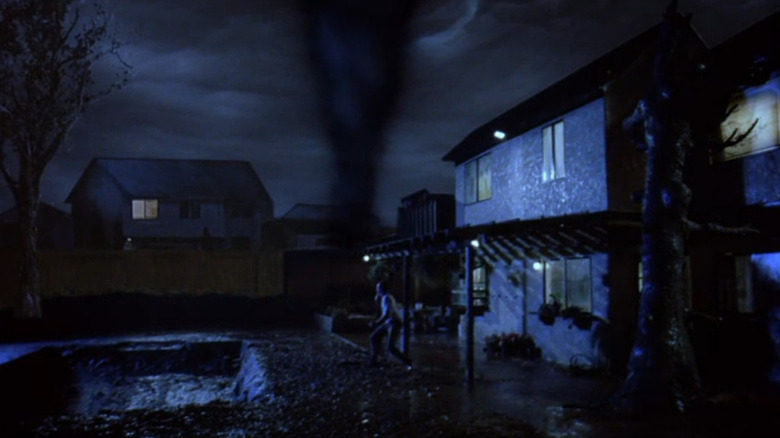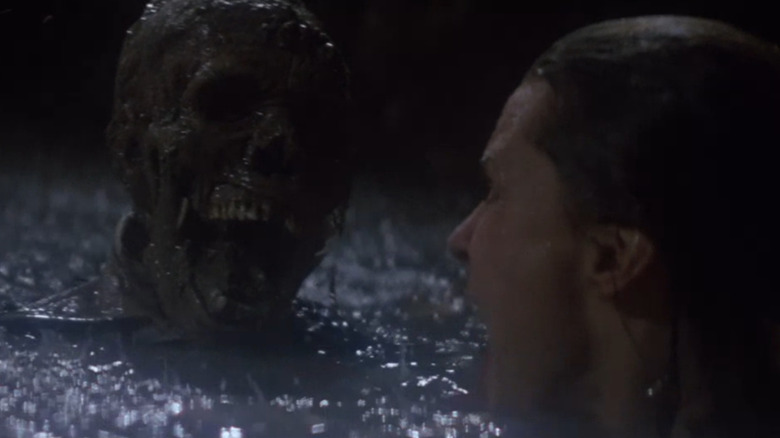Bizarre Things That Happened On The Set Of Poltergeist
A collaborative effort between blockbuster filmmaker Steven Spielberg and horror provocateur Tobe Hooper, "Poltergeist" was an instant summer hit when it was released in June of 1982. Like any good Spielberg production, it had humor and heart aplenty, and like any good Hooper film, it scared the bejeezus out of audiences everywhere.
The movie was so successful MGM churned out two sequels, a TV show, and a 2015 remake. There's nothing like the original, though, and almost 40 years after its release, the film is still just as beloved as ever. In fact, when Rolling Stone conducted a reader's poll of the top horror movies of all time, "Poltergeist" cracked the top 10, along with staples like "The Shining," "The Exorcist," and "The Texas Chain Saw Massacre." It's safe to say the film is a crucial part of not just horror movie history, but movie history itself. But getting from conception to classic was no easy task.
Production confusion, creepy accidents, and eerie coincidences were all among the everyday realities of the film's creation. On top of that, what happened on the film's set ended up giving rise to one of Hollywood's most enduring conspiracy theories and one of its most legendary alleged curses. So, to give you a good idea of just how unusual the production of "Poltergeist" was, let's look at some of the bizarre things that happened during filming.
Practically discovered on set
It's safe to say that five-year-old actress Heather O'Rourke blew audiences away with her hauntingly innocent performance as Carol Anne. And while she didn't quite fall out of the sky (or maybe we should say, ceiling), her casting did seem almost supernatural in how it came about.
"For 'Poltergeist,'" Spielberg explained in a 1982 interview with American Premiere, "I wanted a 'beatific' child ... every mother's dream." He screen-tested a few young actresses — including Drew Barrymore, who he went on to cast in "E.T." — but none of them were quite the right fit.
Fortunately, the producer was eating lunch in the MGM commissary one day and spotted O'Rourke dining with her mom. She made an immediate impression on him. "After lunch," Spielberg recalled, "I walked over to the table and I said, 'Who's the proud mother or agent of this child?' And two hands went up — the mother's and the agent's. So I pulled Heather aside, and I think we made her the deal the next day. She's wonderful."
And she was. Though O'Rourke sadly died at the age of 12, her impact on the film is undeniable. It's hard to imagine any other actor so thoroughly scaring us with a single line: "They're heeeeere."
Whether a twist of fate or random meeting, we're just thankful that Spielberg and O'Rourke made that first, perfect connection.
A real-life medium
Stop and ponder the film for a minute, and you'll likely think of just a handful of elements from it that are quintessentially, overwhelmingly "Poltergeist." Zelda Rubinstein's fearless medium Tangina is likely one of those elements, which makes it hard to believe she was only on the set filming for six days out of the 12-week shooting schedule.
She nailed the part, of course, and as she told Ain't It Cool News, everything she shot made it into the film. You could say she was just perfect for the role — and a part of that may have been due to Rubinstein's own belief in the supernatural. The actress didn't shy away from questions about the unknown, and even claimed in an interview on CNN's "People Now" to have "had incidents in my life that were quite rare, having prior knowledge about things that would occur."
Rubinstein added that "we all have that ability, but it's usually such a frightening, disruptive sensation, that you don't go with it. You turn it off." When asked if it affected whether she accepted the role, she made it clear she would have accepted it no matter what. She did, however, feel "that it added a certain extra touch. That I'm not fearful about phenomena that we don't understand."
If that doesn't sound like Tangina, we don't know what does.
The birth of a conspiracy
While Spielberg co-wrote the script and produced the movie, despite a popular misconception, he did not direct the film. He was working on "E.T." at the time, and a clause in that film's contract prevented him from directing another movie at the same time. Instead, he turned to "Texas Chainsaw Massacre" director Hooper to helm his foray into horror.
Spielberg, though, was incredibly enthusiastic about the project, and he was on-set nearly every day of the shoot. And that kind of involvement from a producer is nearly unheard of. When the movie came out, nearly all promotional material focused on the film's big name: Spielberg. Then a Los Angeles Times story on the film added fuel to the fire by focusing almost exclusively on Spielberg as the movie's creative force. Spielberg tried to clear things up with an open letter to Hooper, apologizing for the confusion and talking about the collaborative nature of their relationship.
Hooper passed away in 2016, but he always insisted he directed that movie, and Spielberg has always backed him up. It seems like every few years someone from the cast or crew has a new take on how the day-to-day set direction went, but most folks insist Hooper did direct. Still, none of that has stopped the conspiracy theorists who, to this day, insist Hooper was just a front to allow Spielberg to secretly direct two movies at once.
A near miss with the King
Though Steven Spielberg ended up sharing writing duties with Michael Grais and Mark Victor, he originally wanted to work with Stephen King. Both Spielberg and King were hugely popular and immensely successful at this point, though the author hadn't really broken into the movie business himself just yet. Only two of his books had been turned into movies — "Carrie" and "The Shining" — while "Salem's Lot" had been adapted as a TV mini-series. Interestingly enough, Tobe Hooper had directed that mini-series.
The idea seemed perfect — too perfect to ever work. When the two Steves spoke to EW in 2018, they were both enthusiastic about their almost-collaboration that, unfortunately, never happened because of a communication breakdown. Spielberg had to get the script done fast, and when he tried reaching out to King, the author was "on a ship going across the Atlantic to England." With no internet, no cell phones, and no way to get in touch in time, Spielberg had to move on and tap two other writers to help him.
It's hard to say how different the film would have been, but we can bet everything from the film's tone to the stories from the set would have been vastly changed had King been involved in the creation of "Poltergeist." We might have even gotten a cameo from the Master of Horror himself.
Providing real nightmare fuel
Even though the dream collaboration never came about, Spielberg did just fine injecting thrills into the story without the help of a horror legend like King. A lot of that is due to the fact that some of the creepiest moments on-screen come from his own worst nightmares.
"'Poltergeist' is about my fears," the producer explained to Rolling Stone's Michael Sragow, "of a clown doll, of a closet, of what was under my bed, of the tree in New Jersey I felt moved whenever there was a wind storm and it scared me with its long, twiggy fingers."
Of course, most of the nightmares were written in to torture poor Robbie, resulting in some of the most grueling shoots for actor Oliver Robins. "It was back in the day, before CGI," Robins told the Daily Mail, "and almost all the effects were practical effects which, as an actor, you had to try and simulate. So whenever the clown was on top of me I had to hold it against my body but make it seem like the clown was actually strangling me." Now that sounds like a nightmare.
Fear of clowns gets a little too real
Yes, the clown really did choke Robins during filming. But it wasn't the part that we're all likely thinking of, when that clown arm wrapped around the boy's neck and pulled him off the bed. The arm was pulled off of Robins' neck during filming and played back in reverse to make it look like it had wrapped around him.
Fortunately, that went off without a hitch, but it was the next few moments that proved dangerous, as that evil clown wasn't done with Robins. "What happened was that contraption got caught around my neck," the actor told the now-defunct publication Icons of Fright. And to make it worse, "I was in a tight confined space under the bed."
Fortunately, the producer was watching out for his safety. "It's almost like a car accident," Robins mused. "You know how a car accident happens so fast you don't remember, but if you don't act something is going to happen? Well, Steven saw that, probably in the video assist, and he pulled me away from it. Who knows what might have happened otherwise. It was very fast and I don't think anything would have happened, but who knows ... maybe I wouldn't be here today."
Learning to fear fear itself
You can't watch "Poltergeist" and not believe that the characters are really, truly frightened. Besides amazing performances, one thing that might have helped was that, to a certain degree, the actors really were frightened. Like any good ghost story, though, it wasn't what they could see that was scaring them, but what they couldn't.
To help get them into the right frame of mind, Robins explained to The Daily Mail, Hooper asked the kids to imagine the scariest things possible. "I'm almost certain that our performances are as strong as they are," he mused, "because we were tapping into something very real and they weren't forced and were coming from a real place within all of us."
It wasn't just the kids, though, that scared themselves, and as their on-screen mom JoBeth Williams wrote during her Reddit AMA, that fear took a toll. "Because we were supposed to be scared so much," she said, "I think everybody's nerves were hypersensitive."
Williams went on to share a story about the apartment she'd been renting during the shoot. Every night she'd come home and notice that the pictures on the wall were crooked, and every night she'd straighten them. She'd head out to the shoot the next day with straight photos, and come back to find them crooked. After a few days of this, she was understandably nervous about her home-away-from-home — until she realized her own slamming of the door as she left was causing the disturbance!
Flirting with twisted minds
Though these days "Poltergeist" is viewed as a spooky, occasionally intense but mostly family-friendly film, it almost ended up far darker than what we got. According to The Telegraph, a number of ideas were changed to soften the film, including one scene towards the end in which Diane is grabbed on her bed and pulled around the room. It was originally supposed to explicitly presented as a ghostly sexual assault, but Hooper would later admit they toned it down in order to get a coveted PG rating (this was before the PG-13 rating would arrive to offer a middle ground between PG and R).
"Tobe would want to go harder," Grais explained to The Telegraph, "Steven would want to go softer, and they met in the middle. They complimented each other."
Of course, Hooper wasn't the only one pushing for twisted. As Grais told Rue-Morgue, he and Victor had originally planned to off Carol Anne in the first act. "[Spielberg] told us, smiling, we were sick but to proceed," the screenwriter said. Eventually, though, the producer came up with another, safer, option, and Carol Anne was just spirited away to another dimension.
Whatever else there is to say about Spielberg being on set nearly every day of filming, it's probably safe to say that without him, we would have ended up with a very different, very R-rated "Poltergeist."
Getting graphically hands-on
Though the movie did earn its PG rating, it was supposedly a bit touch and go. One of the scenes that certainly did not make things easy was Marty's infamous face-tearing scene — and it's the scene that Spielberg had the biggest hand in.
In order to accomplish that flesh-rending feat, the special effects folks created an intricate, tearable bust of actor Martin Cassella's head. It was an impressive bit of sculpture, but they only had one head to work with and one shot to get it right. The thought of messing it up scared Cassella even more than the scene scared the audience.
As he recalled during a "Poltergeist" panel at Indianapolis' Days of the Dead convention, "All I could think was, 'Oh no, this $100,000 prop that they've made...' I finally turned to Tobe and said, 'I have an idea. Let's ask Steven to do it.'"
If anyone was going to take a risk with that scene, Cassella reasoned, it should be the man behind the production. So Hooper and Cassella asked Spielberg to lend a hand — or two. "Steven lit up like a five-year-old," the actor recalled, "and he actually jumped up and down on the set, going, 'Yes! Yes! Yes!'"
They set up the shot, Hooper yelled "Action!" and Spielberg went to work tearing Marty's face apart with gusto. The result was a master class in gross-out effects, and the film's PG rating ensured that it would forever scar generations of children.
Adding a little magic
While most of the film's effects were labor-intensive feats of engineering, there was one scene that was just downright magical: the kitchen chair stacking. In fact, it was so magical that Hooper would later admit it was his favorite scene to shoot.
As he explained in an interview for "Post Mortem with Mick Garris," filming those chairs was "more like a magic trick than a special effect." All it took was some quick moving and a little classic misdirection.
"There's a pre-constructed stack of chairs with two special effects men right beside the camera," the director shared. "And then there were six other effects people waiting in closets underneath the counter. So we started shooting it, and it took four seconds for everyone to pull the chairs out, run into other rooms, then two guys come on, put the assembled stack on the table, and then make a dash out the back way."
It was all done in a single, seamless take as the camera panned away to Williams, then back to the table. Of course, Hooper added, "In dailies, it sounded like a cattle stampede." But that was easy enough to fix. He just took the sound out and gave us one of the creepiest, most surprising chair stackings ever seen on film.
Stormy weather ahead
As the production on "Poltergeist" neared completion, Spielberg hired author James Kahn to write the film's novelization. The catch? He had less than a month to do it. Tight deadline or not, Kahn jumped at the chance. And though he didn't quite make it onto the set, he wasn't far off, moving into Spielberg's MGM offices to work.
He was in those offices late one night towards the end of work on the book, sitting in a conference room surrounded by a slew of video games. He explained on his YouTube channel, "I had just finished the line, 'Thunder and lightning had ripped the sky.' As soon as I finished writing that, this gigantic lightning bolt and thunderclap hit the building. All the lights went out. The front of the window air conditioner blew off across the room and almost hit me."
Kahn's assistant screamed and ran into the room, just before the lights turned back on. But it didn't end there. When the lights did turn on, so did all the video games — and they all began playing themselves.
In the movie, the increasingly intense haunting is heralded by storms, so maybe something supernatural had seeped out from the film and into the studio. Maybe it was the start of the "Poltergeist Curse." Maybe it was just a really terrifying coincidence. Either way, that was enough for Kahn and his assistant, and they ran out of the building.
Filming with the dead
Perhaps the film's most enduring and unfortunate legacy is the "Poltergeist Curse." It's supposedly been the cause of a number of unfortunate accidents and tragic deaths, from O'Rourke succumbing to illness just a few months before the release of "Poltergeist III," to the murder of Dominique Dunne (who played eldest daughter Dana) just a few months after the first film's release.
The curse, for those who believe in it, originated on-set, in the final moments of the film as the dead literally began bursting out of the ground and rising from their graves. Those scenes were so effective because those skeletons looked so terrifyingly real — and that's because they were real. And just as the whole premise of the film is based around the desecration of a graveyard, when folks learned real human remains were used as props, they began to speculate that this had brought on a dark supernatural occurrence.
Craig Reardon, though, who did the special effects in the first film, made it clear to The Telegraph that there was nothing unusual about using real skeletons. The movie industry had been using them as props since Hollywood's earliest days. Unlike the developers of Cuesta Verde, they were not desecrating a graveyard, and plenty of movies have used them without incurring the wrath of the dead. Still, like "Poltergeist" itself, it does make for one hell of a story.
